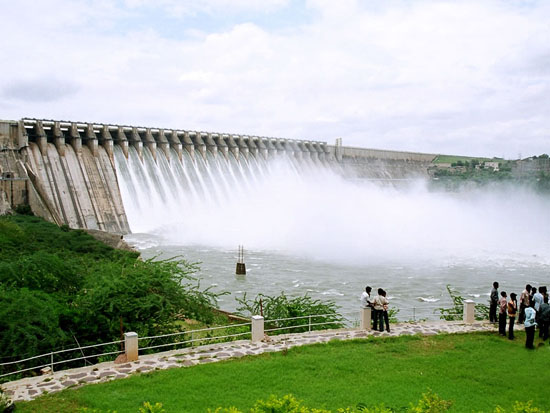Nagarjuna Sagar dam is one of the most visited site in Telangana by young and old alike. Nagarjuna Sagar dam currently holds the record of being the tallest masonry dam (that is, a dam made by way of masonry and is of either gravity or arch type) in the world. Standing at a height of 124 meters, a length of 1 kilometer, and holding back 11,742 million cubic liters of Krishna River water, it is not really surprising if one starts to feel a rush of sheer awe and insignificance when standing before such a massive marvel of architecture and engineering.
It also happens to have created the worlds third largest man-made lake, creating a reservoir that plays a very vital role in the irrigation of vast tracts of land in the surrounding region.
Nagarjuna Sagar Dam is located 150 kilometers from Hyderabad, on the Krishna River, straddling the borders of Nalgonda and Guntur districts. The dam itself provides irrigation to four districts, namely Nalgonda, Guntur, Khammam and Prakasam; the total land it covers goes more than 10 lakh acres.
Construction of the dam started in February of 1956, but it was hampered due to the scarcity of funds for the procurement of modern machinery. As a result, stone instead of concrete was used. To expedite the construction, a cement factory was created near Macherla, a municipality in the Guntur district, and a railway line was erected to connect the factory to the construction site. Stones were supplied from nearby quarries in Sunkesula, while sand was obtained from Halia river and Rayavaram stream. The project was finally completed in 1969, and full usage of the dam came in 1972 after the crest gates were fit in. All in all, around 1300 crore rupees was spent on the dam, including the maintenance up until 2005. There were between 45,000 to 70,000 workers who participated in the construction of the dam.
Aside from the dam itself, there are other attractions nearby as well. The Nakarjunda Konda Island lies in the middle of the lake, containing the historical remnants of a Buddhist settlement that was relocated there during the dam construction.
It also happens to have created the worlds third largest man-made lake, creating a reservoir that plays a very vital role in the irrigation of vast tracts of land in the surrounding region.
Nagarjuna Sagar Dam is located 150 kilometers from Hyderabad, on the Krishna River, straddling the borders of Nalgonda and Guntur districts. The dam itself provides irrigation to four districts, namely Nalgonda, Guntur, Khammam and Prakasam; the total land it covers goes more than 10 lakh acres.
Construction of the dam started in February of 1956, but it was hampered due to the scarcity of funds for the procurement of modern machinery. As a result, stone instead of concrete was used. To expedite the construction, a cement factory was created near Macherla, a municipality in the Guntur district, and a railway line was erected to connect the factory to the construction site. Stones were supplied from nearby quarries in Sunkesula, while sand was obtained from Halia river and Rayavaram stream. The project was finally completed in 1969, and full usage of the dam came in 1972 after the crest gates were fit in. All in all, around 1300 crore rupees was spent on the dam, including the maintenance up until 2005. There were between 45,000 to 70,000 workers who participated in the construction of the dam.
Aside from the dam itself, there are other attractions nearby as well. The Nakarjunda Konda Island lies in the middle of the lake, containing the historical remnants of a Buddhist settlement that was relocated there during the dam construction.











